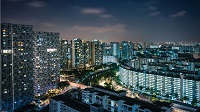For more information, please refer to:
Media Releases
22 Mar 2022
Sets out scenarios and shifts needed in the power sector to achieve ambition
- The Energy 2050 committee released its report today concluding that it is realistic for Singapore’s power sector to aspire to achieve net-zero emissions by 2050. The report noted that the entire energy value chain would have to undergo transformational changes to achieve this, and acknowledged that it would be challenging due to uncertainties such as geopolitical trends and technological advancements.
- The report’s findings are timely and significant, given Singapore’s raised ambition to achieve net-zero by or around mid-century, and the fact that the power sector accounts for about 40% of Singapore’s carbon emissions. The Committee, which consists of experts from the private and public sectors, was commissioned by the Energy Market Authority (EMA) to guide the planning of Singapore’s future energy system.
- While there are various pathways for the power sector to achieve net-zero by 2050, the Committee identified a number of strategies that would enable Singapore to be well positioned for this transition. These include how Singapore must decarbonise and diversify its energy supply mix, enhance its power grid with advanced control systems and digital technologies. In addition, Singapore will need to actively manage demand growth and consumption patterns. In the journey towards net-zero, the Committee sees an opportunity for Singapore to position itself as a technology frontrunner and become a living lab for innovative energy solutions.
- While achieving net-zero for the power sector is feasible, the Committee recognised that it would be a complex and challenging endeavour with inevitable trade-offs. Uncertainties such as geopolitical trends and technological advancements in various low-carbon energy solutions could lead to changes in Singapore’s decarbonisation plan. Decarbonisation will also be costly – investments will need to be made in infrastructure such as the power grid, to support the increasing number of renewable energy and distributed energy resources (DERs)[1]. This would be a trade-off for greater sustainability and reliability.
- Mr Ngiam Shih Chun, Chief Executive of EMA, said, “The power sector’s journey towards net-zero emissions will be complex and challenging. This study by the Energy 2050 Committee serves as an invaluable guide and will help to signal the path ahead to all the key stakeholders in the energy sector.”
- “While the Government will have to play a leading role in driving the energy transformation efforts, it is also critical for all other sectors and Singaporeans to embrace the need for the energy transition and contribute. We are optimistic that this can happen, and Singapore can arrive in 2050 with a brighter and greener future,” said Mr Choi Shing Kwok, Chairman of the Energy 2050 Committee.
- EMA had in 2019, announced the Singapore Energy Story, laying out the plans to decarbonise the sector. Since then, EMA has announced its target to import up to 4 gigawatts of low-carbon electricity by 2035 and issued the first request-for-proposal last year. It is also taking active steps to invest in the research of low-carbon technologies such as hydrogen and geothermal energy as well as carbon capture, utilisation and storage (CCUS) through the $55 million Low-Carbon Energy Research Funding Initiative. EMA continues to monitor global developments in areas such as nuclear energy and their implications for Singapore.
- Together with industry partners and other government agencies, EMA is working on a power grid digital twin to enhance Singapore’s grid resilience and reliability, and support the transition towards cleaner energy sources. To encourage energy conservation during periods of tight market conditions, EMA launched demand-side management schemes such as the Demand Response and Interruptible Load programmes. These allow consumers to reduce or shift their energy consumption in response to tight supply, in exchange for compensation.
- As Singapore’s energy sector transitions towards a more sustainable future, there are growth opportunities that businesses can tap on and that the workforce can look forward to. New businesses and jobs in clean energy will emerge in areas such as solar, energy storage systems, hydrogen and smart power grids. EMA will further study the recommendations in the Committee’s report and announce new developments when ready.
- The full report from the Committee is available on this page.
Strategies Towards Power Sector Decarbonisation
Challenges and Trade-offs for Power Sector Decarbonisation
Ongoing Efforts to Decarbonise the Power Sector
Annex A: About the Energy 2050 Committee
Annex B: Infographic on the report’s key strategies and recommendations
[1] Examples of DERs include solar and energy storage systems, which are located at end users’ premises.















